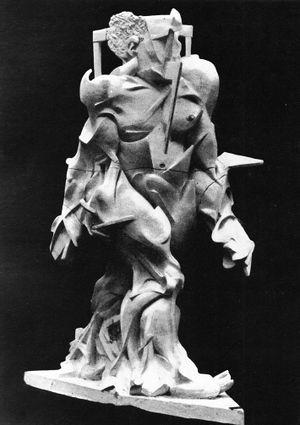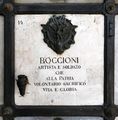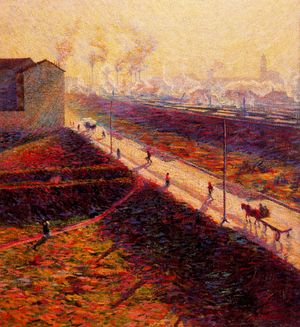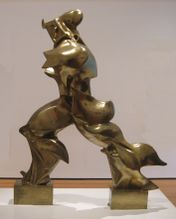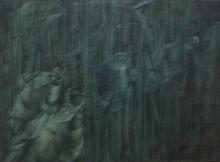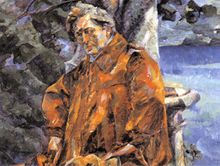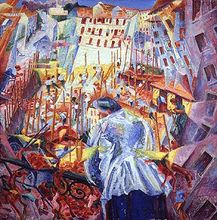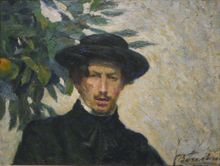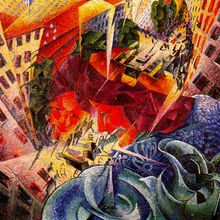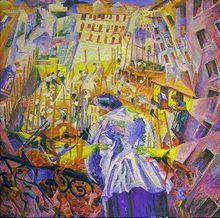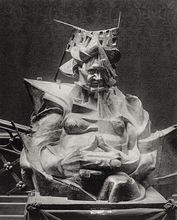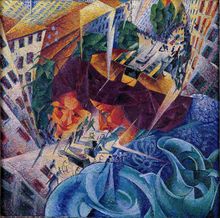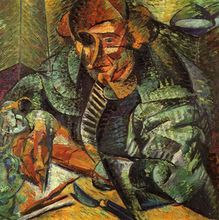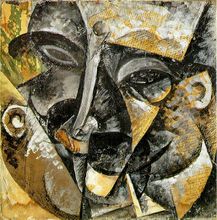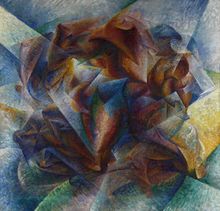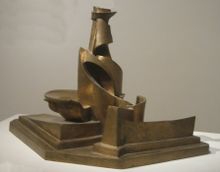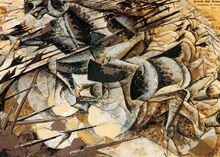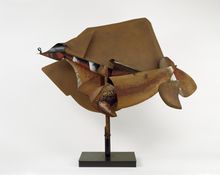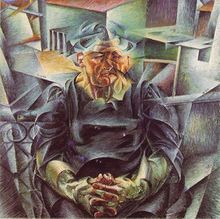أومبرتو بوتشيوني
Umberto Boccioni | |
|---|---|
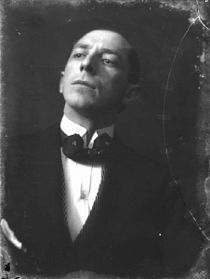 Umberto Boccioni | |
| وُلِدَ | 19 October 1882 Reggio Calabria, Italy |
| توفي | 17 أغسطس 1916 (aged 33) Verona, Italy |
| القومية | Italian |
| التعليم | Accademia di Belle Arti di Roma |
العمل البارز | Unique Forms of Continuity in Space The City Rises The Street Enters the House |
| الحركة | Futurism |
أومبرتو بوتشيوني (Umberto Boccioni ؛ US: /boʊˈtʃoʊni, bɒˈ-, bɔːˈ-/؛[1][2][3] النطق بالإيطالية: [umˈbɛrto botˈtʃoːni]؛ و. 19 اكتوبر 1882 – 17 أغسطس 1916). واحد من النحاتين الإيطاليين في مطلع القرن العشرين. وكان أيضًا رسامًا بالزيت. كما يعد واحدًا من مجموعة الفنانين التجريبيين والشعراء الإيطاليين الذين قرروا تنظيم أنفسهم عام 1909م وكوّنوا جماعة تعرف باسم المُستقبليين. انظر: المستقبلية. حاول بوتشيوني التعبير، من خلال عمله بالنحت، عن أفكار مستقبلية معينة وعن حركة الأجسام وعن الفضاء. كما حاول التصوير أو التعبير عن توليفة شيء ما مع مسار حركته أو مع الفضاء المحيط به وذلك من خلال التحريف وتحديد الأماكن المعقدة للأشكال والصور. ويتضح في أعماله النحتية الأشكال الفريدة للاَّنهائية (للتواصل) في الفضاء. وكان بوتشيوني أول من شجَّع ممارسة المزج الحر بين المواد المختلفة المستخدمة في فن النحت.
ويعد عمله "صحوة المدينة" الذي يظهر في رسومه الزيتية مثالاً على أعماله الزيتية المتعلقة بالمستقبل.
وُلِد أومبرتو بوتشيوني في 19 اكتوبر 1882 في ردجو كالابريا بإيطاليا، ابناً لموظف حكومي صغير ينحدر من منطقة رومانيا في الشمال، وتطلبت وظيفته التنقل في أرجاء إيطاليا.
سيرته
In 1914 he published Pittura e scultura futuriste (dinamismo plastico) explaining the aesthetics of the group:
"While the impressionists paint a picture to give one particular moment and subordinate the life of the picture to its resemblance to this moment, we synthesize every moment (time, place, form, color-tone) and thus paint the picture.
He exhibited in London, together with the group, in 1912 (Sackville Gallery) and 1914 (Doré Gallery): the two exhibitions made a deep impression on a number of young English artists, in particular C.R.W. Nevinson, who joined the movement. Others aligned themselves instead to its British equivalent, Vorticism, led by Wyndham Lewis.
"Boccioni's gift was to bring a fresh eye to reality in ways that, we now recognise, defined the nature of the modern movement in the visual arts and literature, too."[4] --Michael Glover (art critic, The Independent)
أعماله

الپورتريهات والمناظر الطبيعية المبكرة From 1902 to 1910, Boccioni focused initially on drawings, then sketched and painted portraits – with his mother as a frequent model. He also painted landscapes – often including the arrival of industrialization, trains and factories for example. During this period, he weaves between Pointillism and Impressionism, and the influence of Giacomo Balla, and Divisionism techniques are evident in early paintings (although later largely abandoned). The Morning (1909) was noted for "the bold and youthful violence of hues" and as "a daring exercise in luminosity."[5] His 1909–10 Three Women, which portrays his mother and sister, and longtime lover Ines at center, was cited as expressing great emotion – strength, melancholy and love.[5]
تطور المستقبلية
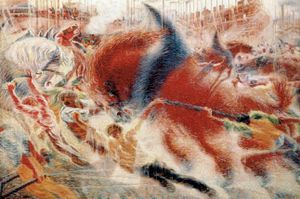
معرض الصور
Unique Forms of Continuity in Space, 1913
bronze (depicted on Italian 20 cent euro coin)
Museum of Modern Art, New YorkStates of Mind III; Those Who Stay, 1911
oil on canvas painting
Museum of Modern Art, New YorkPortrait (detail) of Ferruccio Busoni, 1916
Galleria Nazionale d'Arte Moderna, RomeA strada entra nella casa, 1911
Sprengel-Museum, HannoverSelf-portrait, 1905 (oil on canvas)
Metropolitan Museum of Art, New YorkVisioni simultanee, ca. 1912
Von Der Heydt Museum, WuppertalStates of Mind III; Those Who Stay, 1911, Museum of Modern Art, New York
Modern Idol, 1911, Estorick Collection of Modern Italian Art, Islington, London
The Street Enters the House, 1911, Sprengel-Museum, Hanover
Visioni simultanee, 1912, Von Der Heydt Museum, Wuppertal
Dynamism of a Soccer Player, Museum of Modern Art, New York
Charge of the Lancers, 1915, Collection of Riccardo and Magda Jucker, Milan
Dynamism of a Speeding Horse + Houses (Dinamismo di un cavallo in corsa + case), 1915
Horizontal Volumes, 1915, Solomon R. Guggenheim Museum
المصادر
- Guggenheim Collection's Boccioni entry
المراجع
- ^ "Boccioni". The American Heritage Dictionary of the English Language (5th ed.). HarperCollins. Retrieved 28 July 2019.
- ^ "Boccioni". Collins English Dictionary. HarperCollins. Retrieved 28 July 2019.
- ^ قالب:Cite Merriam-Webster
- ^ Michael Glover (27 January 2009). The drawing and sculpture of Umberto Boccioni. The Independent. Retrieved October 2015.
- ^ أ ب Ester Coen (1989). Umberto Boccioni. New York: The Metropolitan Museum of Art. pp. xiii–xvi. ISBN 0870995227.
خطأ استشهاد: الوسم <ref> ذو الاسم "BR2004" المُعرّف في <references> غير مستخدم في النص السابق.
خطأ استشهاد: الوسم <ref> ذو الاسم "Guardian2009" المُعرّف في <references> غير مستخدم في النص السابق.
خطأ استشهاد: الوسم <ref> ذو الاسم "gugg" المُعرّف في <references> غير مستخدم في النص السابق.
خطأ استشهاد: الوسم <ref> ذو الاسم "gugg2" المُعرّف في <references> غير مستخدم في النص السابق.
خطأ استشهاد: الوسم <ref> ذو الاسم "journal" المُعرّف في <references> غير مستخدم في النص السابق.
خطأ استشهاد: الوسم <ref> ذو الاسم "looted" المُعرّف في <references> غير مستخدم في النص السابق.
خطأ استشهاد: الوسم <ref> ذو الاسم "MetPub" المُعرّف في <references> غير مستخدم في النص السابق.
خطأ استشهاد: الوسم <ref> ذو الاسم "MetUFCS" المُعرّف في <references> غير مستخدم في النص السابق.
خطأ استشهاد: الوسم <ref> ذو الاسم "MoMA" المُعرّف في <references> غير مستخدم في النص السابق.
خطأ استشهاد: الوسم <ref> ذو الاسم "NYM" المُعرّف في <references> غير مستخدم في النص السابق.
خطأ استشهاد: الوسم <ref> ذو الاسم "NYT1988" المُعرّف في <references> غير مستخدم في النص السابق.
خطأ استشهاد: الوسم <ref> ذو الاسم "NYT1989" المُعرّف في <references> غير مستخدم في النص السابق.
خطأ استشهاد: الوسم <ref> ذو الاسم "NYT2004" المُعرّف في <references> غير مستخدم في النص السابق.
خطأ استشهاد: الوسم <ref> ذو الاسم "NYT98G" المُعرّف في <references> غير مستخدم في النص السابق.
خطأ استشهاد: الوسم <ref> ذو الاسم "trecc" المُعرّف في <references> غير مستخدم في النص السابق.
خطأ استشهاد: الوسم <ref> ذو الاسم "wc" المُعرّف في <references> غير مستخدم في النص السابق.
خطأ استشهاد: الوسم <ref> ذو الاسم "wc2" المُعرّف في <references> غير مستخدم في النص السابق.
خطأ استشهاد: الوسم <ref> ذو الاسم "wc3" المُعرّف في <references> غير مستخدم في النص السابق.
خطأ استشهاد: الوسم <ref> ذو الاسم "wc4" المُعرّف في <references> غير مستخدم في النص السابق.
<ref> ذو الاسم "wc5" المُعرّف في <references> غير مستخدم في النص السابق.للاستزادة
- Giovanni Lista, Futurisme : manifestes, documents, proclamations, L'Age d'Homme, coll. "Avant-gardes", Lausanne, 1973.
- Umberto Boccioni, Dynamisme plastique, textes réunis, annotés et préfacés par Giovanni Lista, traduction de Claude Minot et Giovanni Lista, L'Age d'Homme, coll. "Avant-gardes", Lausanne, 1975.
- Giovanni Lista, "De la chromogonie de Boccioni à l'art spatial de Fontana", in Ligeia, dossiers sur l'art, n° 77-78-79-80, juillet-décembre 2007, Paris.
- Giovanni Lista, Le Futurisme : création et avant-garde, Éditions L'Amateur, Paris, 2001.
- Danih Meo, Della memoria di Umberto Boccioni, Mimesis, Milano 2007.
وصلات خارجية
- Umberto Boccioni papers, 1899–1986. Getty Research Institute, Research Library. Los Angeles, California.
- قالب:MMoAobject – Exhibition catalog (15 September 1988, to 8 January 1989)
- مواليد 1882
- وفيات 1916
- مصورون مستقبليون إيطاليون
- نحاتون إيطاليون
- نحاتون مستقبليون
- كولاج
- People from the Province of Reggio Calabria
- عسكريون إيطاليون قتلوا في الحرب العالمية الأولى
- وفيات متعلقة بركوب الخيل
- People from Reggio Calabria
- Works by Umberto Boccioni
- 20th-century Italian painters
- 20th-century Italian sculptors

